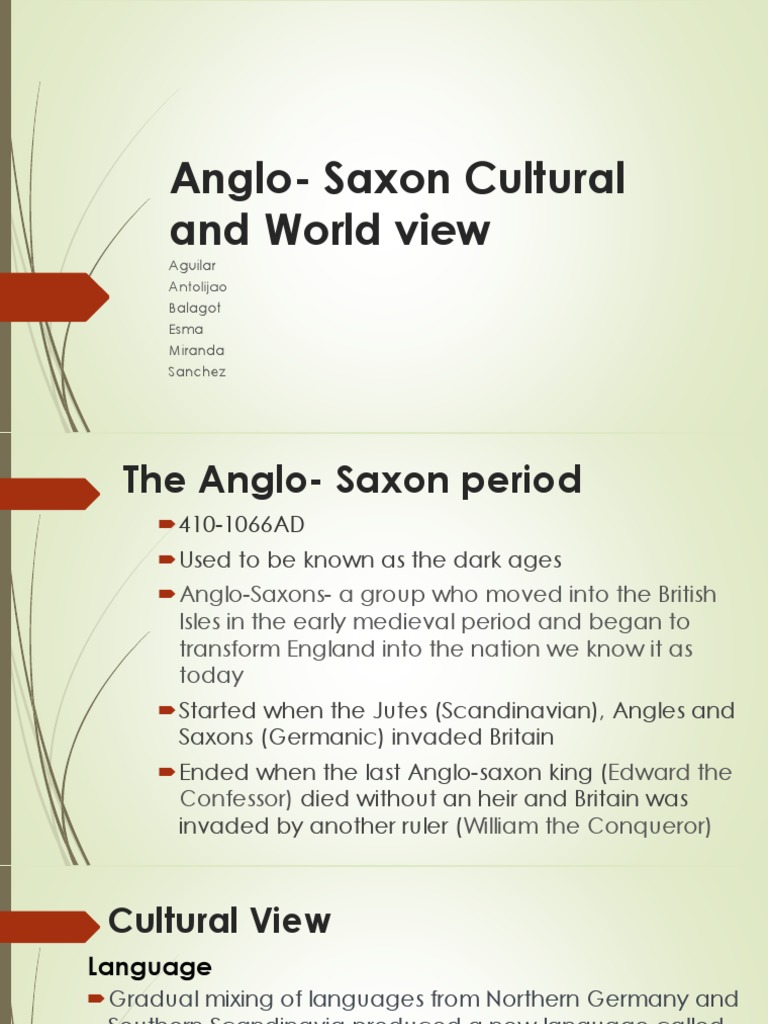The Anglo-Saxons represent a formative cultural tapestry that shaped what is now known as England. Their prominence arose from the amalgamation of various tribes—primarily the Angles, Saxons, and Jutes—during the early medieval period. To understand their essence involves delving into the characteristics of their culture, language, and enduring legacy, all viewed through the lens of cultural relativism. This perspective asserts that a society’s beliefs and practices should be understood based on its own cultural context, not judged through external norms.
The cultural characteristics of the Anglo-Saxons reveal a rich and complex societal framework. At the heart of their cultural identity was a strong kinship system and an intricate tribal organization. Society was primarily agrarian, relying on agriculture and animal husbandry as fundamental to its subsistence. Villages often functioned as the nucleus of social life, where communal ties were both valued and essential for survival. This embedded sense of community engendered a collaborative ethos; farmers would share resources and labor during crucial planting or harvesting periods. Such communal practices underpinned the very fabric of Anglo-Saxon existence, illustrating a deep-seated interdependence that went beyond mere economics.
The spiritual life of the Anglo-Saxons was equally compelling. Initially steeped in pagan traditions, their belief system revolved around a pantheon of deities and a profound connection to the natural world. Gods such as Woden, Thunor, and Tiw represented various aspects of life, including war, agriculture, and fertility. Rituals and ceremonies were integral to community life, embodying a worldview that intertwined the sacred with the quotidian. The arrival of Christianity, notably in the seventh century, began to transform these beliefs. The merging of Christian doctrine with native customs created a unique spiritual hybrid that still resonates within modern British culture.
Language serves as a potent marker of cultural identity. The Anglo-Saxon vernacular, known as Old English, constituted a significant linguistic evolution. It derived from Germanic dialects and was characterized by its robust inflectional system—a system that distinguished it from many modern languages. Old English poetry, with its alliterative verse and vivid imagery, is a testament to the Anglo-Saxon literary tradition. Works such as “Beowulf” encapsulate the heroic ethos of the time, reflecting societal values such as loyalty, bravery, and the significance of mead halls as centers of social interaction and storytelling. The survival of these texts illustrates not merely a literary heritage but a cultural lineage that underscores the communal experiences of the Anglo-Saxon people.
This linguistic legacy extends beyond its literary corpus. The very structure of Modern English retains vestiges of its Anglo-Saxon roots. Many foundational words, particularly those pertaining to agriculture, family, and everyday life, derive from Old English. The interplay between this ancient language and later Norse and Norman influences serves as a microcosm of cultural exchange, echoing themes of adaptation, resilience, and transformation. Such linguistic evolution underscores the notion of cultural relativism; language is inextricably linked to identity, and by appreciating this evolution, one can better comprehend the multi-faceted character of Anglo-Saxon society.
In terms of legacy, the impact of the Anglo-Saxons is profoundly etched in various dimensions of contemporary culture. Their legal frameworks, for instance, established some of the earliest forms of governance in medieval England. With principles that emphasized collective decision-making and justice, the emergence of local courts, or ‘hundreds,’ paved the way for concepts of democratic representation. Moreover, the socio-political structures that evolved during this period laid essential groundwork for the future British legal system. A cultural relativist approach encourages us to recognize that these early forms of governance stemmed from a distinct societal context, shaped by their agrarian lifestyle and communal values.
Furthermore, the Anglo-Saxons played a pivotal role in the development of art and architecture, leaving a distinct mark on the landscape. Their craftsmanship is evident in jewelry, weaponry, and illuminated manuscripts, characterized by intricate designs and symbolisms that reflected both social status and spiritual beliefs. The grandeur of churches—particularly during the conversion to Christianity—also testifies to their burgeoning architectural ambitions. The adoption of stone masonry and the Romanesque style signified an evolution in aesthetic sensibility, reinforcing their beliefs and values in a tangible form.
However, it is essential to approach the Anglo-Saxons’ complexities through an unencumbered lens of cultural relativism. Their societal dynamics cannot be fully understood without considering the distinct historical circumstances they encountered. The influx of Viking settlers throughout the eighth and ninth centuries posed challenges and opportunities that reshaped Anglo-Saxon culture, leading to significant exchanges of ideas, customs, and even genetic heritage. This tumultuous interaction prompted adaptability and flexibility, traits inherent to the Anglo-Saxon spirit.
The narrative of the Anglo-Saxons is not merely a chronicle of tribes and battles; it encapsulates themes of resilience, cultural dynamism, and coexistence. Their legacy, thus, is one characterized not by conquest alone but by adaptation and synthesis. Through the lens of cultural relativism, we can discern the intricate nuances of an ethereal culture that profoundly influenced the emergent English identity—a culture where the interplay of language, customs, and societal structures resonates through centuries.
In conclusion, the Anglo-Saxon period offers a compelling case study in cultural characteristics. By exploring their agrarian lifestyle, spiritual beliefs, linguistic heritage, and socio-political structures, one can appreciate the contemporary significance of this ancient people. They embody a historical narrative that underscores the complexity of identity, reminding us that culture is an evolving interplay of influences and adaptations that defies simplistic interpretations.
